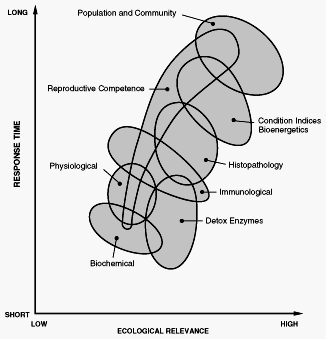


Concept of the Biological Indicator approach for assessing aquatic
ecosystem health. Responses of fish to environmental stressors fall along gradients of
response time and ecological relevance.

Can bioindicators be used to successfully evaluate the effects of environmental stressors such as contaminants on aquatic ecosystem health?

Bioindicators have been applied in a variety of aquatic systems (streams, reservoirs, rivers, estuaries) in the eastern United States to assess the nature and extent of environmental degradation. Applications of bioindicators in some systems have proven to be not only reliable indicators of ecosystem health but also potential sentinels of human health.
Bioindicators have also been successfully used to evaluate the effectiveness of remedial actions and to determine if industry is complying with environmental regulations.

Adams, S. M. 1990. Status and use of biological indicators for evaluating the effects of stress on fish. Amer. Fish. Sym. 8:1-8.
Adams, S. M. and M. G. Ryon. 1994. A comparison of health assessment approaches for evaluating the effects of contaminant-related stress on fish populations. J. Aquat. Ecosystem Health 3:15-25.
Integrated Assessment Briefs. 1995. ORNL/M-4227. Oak Ridge National Laboratory, Oak Ridge, TN.